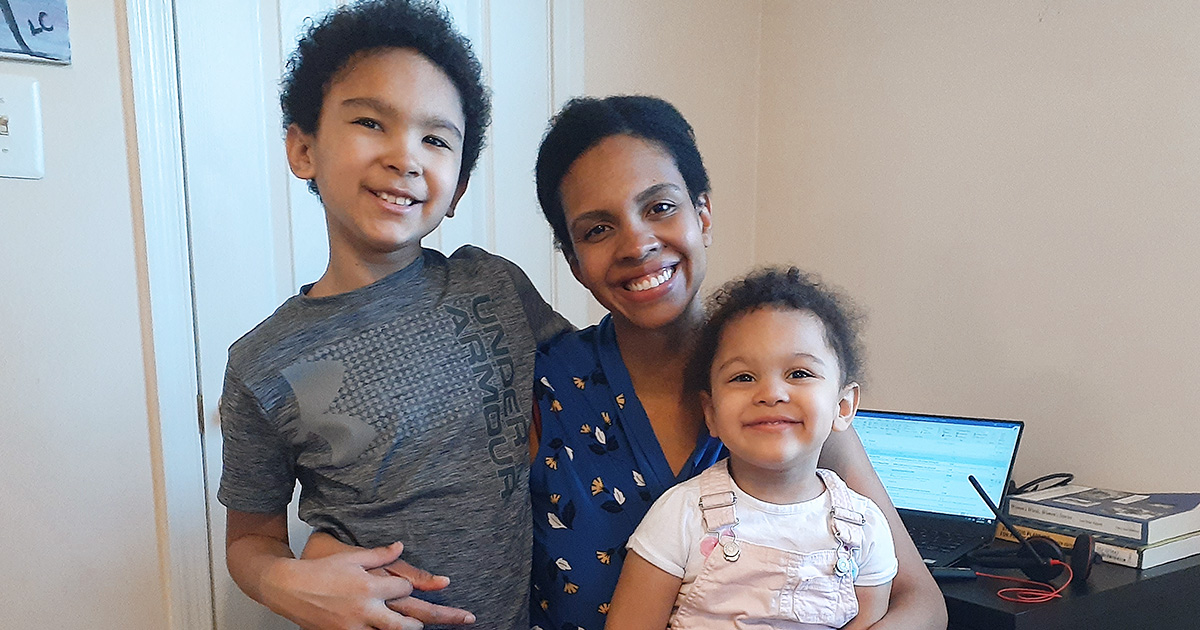People often ask me how I parent my two young children, serve as a public affairs specialist at Mathematica, and attend graduate school at Georgetown University. It is the proverbial question that working parents are routinely asked: “How do you juggle it all?” The answer is that I do not balance it alone. I have a support network that includes my spouse, child care providers, teachers, and employer. I use the before- and after-school care program at my son’s elementary school, a child care center for my daughter’s preschool education, and Mathematica’s telework program and leave options to create work-life balance.
The COVID-19 pandemic, however, has upended an essential part of that network—child care. My son’s school has closed for the remainder of the school year, and my daughter’s day care is closed for the near future. To adhere to physical distancing guidelines and stay-at-home orders, I have been parenting and educating my children while working remotely without the daily support of their teachers and child care providers. My working days are now like a mental tug-of-war; I go from making grilled cheese sandwiches to writing a press release or communications plan, from participating on conference calls to reviewing fractions and multiplication factors with my eight year old, and then singing the ABCs with my 3-year-old. To say this new normal is challenging is an understatement. Yet, I know I have it better than many working parents and caregivers because I am able to telework and have access to paid sick leave. Furthermore, Mathematica recently generously provided working parents and caregivers like myself with additional paid leave to care for our loved ones during this pandemic.
The Pew Research Center reports that only 7 percent of civilian workers in the United States have access to telework or a flexible workplace benefit, and 24 percent of U.S. civilian workers do not have access to paid sick leave. I believe a positive to this global health crisis is that people are becoming more aware of how many American workers lack these benefits and how this impedes their ability to earn a living when their loved ones become sick, when they become sick themselves, or when schools and day care centers are closed.
My transition to working remotely full time while parenting, albeit stressful, has been buffered by the fact that Mathematica offers several flexible workplace benefits. For example, with offices around the country, the need for remote work with our partners, and a large percentage of staff who have been working remotely for years, we already had a well-established telework program. Our work culture—and our information technology infrastructure—was built around being able to connect no matter where you are on a given day, so we were not as impacted by office closures and physical distancing guidelines as other organizations.
I have never been more thankful that working remotely was already a major part of our work culture. Because I had already been teleworking part time and working with colleagues based in different office locations, I was already well acclimated to using video conference platforms, email, and instant messaging to collaborate and complete assignments. As I have adjusted to working and parenting within the confines of my home, I have found that my colleagues still feel close. When everything else in my life shifted, being able to connect with my colleagues in familiar ways felt more like a constant, which has eased my mental load and made me feel like I still have access to a community.
I am also immensely grateful for the employee resource groups that Mathematica offers staff. These are groups for staff to connect with others who share a common identity. As a member of Mathematica’s Parent and Caregivers employee resource group, I have been able to share concerns and gain advice with other colleagues who are also parenting and working during this pandemic.
Through the group’s chatroom, we have been sharing tips for reducing stress and selecting home-based educational and enrichment activities. It is also nice to know that I am not alone in worrying that my 3-year-old is going to turn my next videoconference meeting into her rendition of “Let It Go” from her favorite movie, Frozen. We share funny stories about our new “co-workers” and our clever solutions to being present employees and caring parents. I think the most unique idea a member shared was creating a mailbox outside her office for her children so they could deliver their artwork and notes without disrupting her conference calls. I have also appreciated the active involvement in our chat room by our ERG group leaders and our new Chief Human Resources Officer. Through their participation, members of the parent and caregiver community have been able to receive very timely responses to questions around our leave options.
Parents and caregivers all over the world are trying to figure out how to work, educate, and nurture their loved ones in physical isolation. And like many students, I have also had to accept that this coming May I will not walk across a stage to receive my master’s degree to applause but rather will receive it quietly from my mailbox. In the midst of these challenges, it is important to recognize the value of support networks and flexible work options for parents and caregivers. Working parents and caregivers need a community and policies to serve society and our families. My hope is that when this pandemic is over, stories like mine—where employees have the option to telework, have access to paid leave, and have support groups—are more the norm than the exception. And I hope that “we’re all in this together” becomes more than an expression and instead reflects how we value and support each other.



